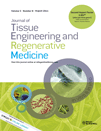Characterization of human myoblast differentiation for tissue-engineering purposes by quantitative gene expression analysis
Abstract
Tissue engineering of skeletal muscle is an encouraging possibility for the treatment of muscle loss through the creation of functional muscle tissue in vitro from human stem cells. Currently, the preferred stem cells are primary, non-immunogenic satellite cells ( = myoblasts). The objective of this study was to determine the expression patterns of myogenic markers within the human satellite cell population during their differentiation into multinucleated myotubes for an accurate characterization of stem cell behaviour. Satellite cells were incubated (for 1, 4, 8, 12 or 16 days) with a culture medium containing either a low [ = differentiation medium (DM)] or high [ = growth medium (GM)] concentration of growth factors. Furthermore, we performed a quantitative gene expression analysis of well-defined differentiation makers: myogenic factor 5 (MYF5), myogenin (MYOG), skeletal muscle αactin1 (ACTA1), embryonic (MYH3), perinatal (MYH8) and adult skeletal muscle myosin heavy chain (MYH1). Additionally, the fusion indices of forming myotubes of MYH1, MYH8 and ACTA1 were calculated. We show that satellite cells incubated with DM expressed multiple characteriztic features of mature skeletal muscles, verified by time-dependent upregulation of MYOG, MYH1, MYH3, MYH8 and ACTA1. However, satellite cells incubated with GM did not reveal all morphological aspects of muscle differentiation. Immunocytochemical investigations with antibodies directed against the differentiation markers showed correlations between the gene expression and differentiation. Our data provide information about time-dependent gene expression of differentiation markers in human satellite cells, which can be used for maturation analyses in skeletal muscle tissue-engineering applications. Copyright © 2011 John Wiley & Sons, Ltd.




